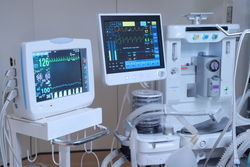
CAA or CRNA?(MD)
Scope of Practice
Certified Anesthesiologist Assistants (CAAs) practice in the Anesthesia Care Team (ACT) with Physician Anesthesiologist oversight. The scope of clinical practice for CAAs is identical to that of nurse anesthetists working in the ACT.
The scope of practice of CAAs is determined by the following:
• The Physician Anesthesiologist • The hospital credentialing body
• The state’s board of medicine • Any applicable state statute or regulation.
Job Description
The Anesthesiologist Assistant (AA) is qualified by academic and clinical education to provide anesthetic care under the direction of a qualified physician anesthesiologist. The physician anesthesiologist who is responsible for the Anesthesiologist Assistant is available to prescribe and direct particular therapeutic interventions.
By virtue of the basic medical science education and clinical practice experience, the Anesthesiologist Assistant is proficient in the use of contemporary patient monitoring and interpretation of data in all anesthesia care environments. The Anesthesiologist Assistant provides patient care that allows the supervising physician anesthesiologist to use his or her own medical education more efficiently and effectively.
The Anesthesiologist Assistant is prepared to gather patient data, perform patient evaluation, and to administer and document the therapeutic plan that has been formulated for the anesthetic care of the patient. The tasks performed by AAs reflect regional variations in anesthesia practice and state regulatory factors.
Under the direction of a physician anesthesiologist, in agreement with the ASA Statement on the Anesthesia Care Team (ACT) and in accordance with the AAAA Statement on the ACT, the Anesthesiologist Assistant’s functions include, but are not limited to, the following:
a. Obtain an appropriate and accurate preanesthetic health history, perform an appropriate physical
examination, and record pertinent data in an organized and legible manner;
b. Obtain diagnostic laboratory and related studies as appropriate, such as drawing arterial and venous blood samples and any other necessary patient fluids;
c. Insert and interpret data from invasive monitoring modalities such as arterial lines, pulmonary artery catheterization, and central venous lines, as delegated by the supervising physician anesthesiologist;
d. Administer anesthetic agents and controlled substances under the direction of a supervising physician anesthesiologist. This includes, but not limited to, administration of induction agents, maintaining and altering anesthesia levels, administering adjunctive treatment and providing continuity of anesthetic care into and during the post-operative recovery period;
e. Establish and maintain appropriate airway management and provide appropriate ventilatory support;
f. Apply and interpret advanced monitoring techniques;
g. Make post-anesthesia patient rounds by recording patient progress notes, compiling and recording case summaries, and by transcribing standing and specific orders;
h. Evaluate and treat life-threatening situations, such as cardiopulmonary resuscitation, on the basis of established protocols (BLS, ACLS, and PALS);
i. Perform duties in intensive care units, pain clinics, and other settings, as appropriate;
j. Train and supervise personnel in the calibration, troubleshooting, and use of patient monitors;
k. Perform administrative duties in an anesthesiology practice or anesthesiology department, including
management of personnel;
l. Participate in the clinical instruction of others; and
m. Perform and monitor regional anesthesia to include, but not limited to, spinal, epidural, IV regional, and other special techniques such as local infiltration and nerve blocks.